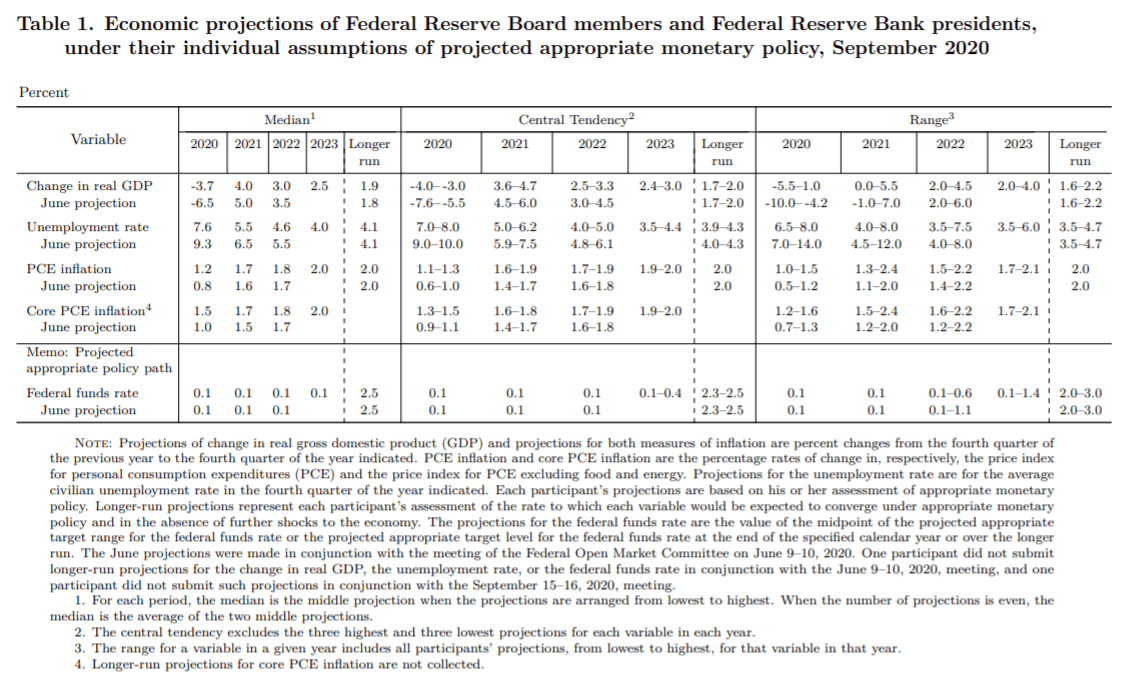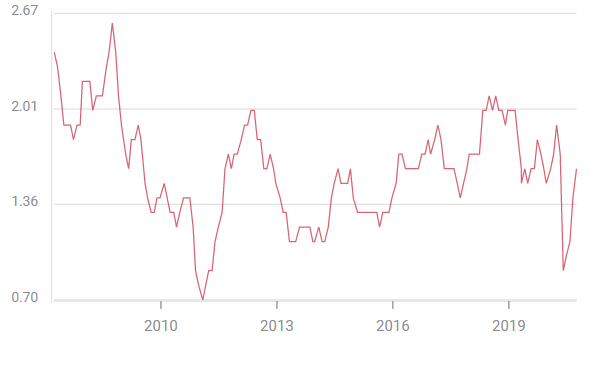- Edited minutes of the September 15-16 Federal Reserve Open Market Committee meeting.
- What were the discussions around the extension of guidance to 2023?
- Projection Materials portray an improved economy since the June release.
- FOMC minutes provide background information for markets, not trading catalysts.
The Federal Reserve's September meeting introduced two important policy changes, inflation averaging and extended rate guidance. Chairman Jerome Powell's emphasis on fiscal stimulus in his speeches and public appearances has presented the third leg of the Fed's pandemic support policies.
The governors replaced their 2% price target with inflation averaging. This new standard for interest rate policy will permit prices to run above 2% for as long as it take to bring the overall rate up to target before the FOMC will consider rate hikes. They also extended guidance for the fed funds rate out to four years, adding 2023 as the final specified year before the final 'longer run' category.
In combination the two new directives officially sanction what the Fed has been doing in practice since the financial crisis of over a decade ago, putting inflation policy in distant second place to promoting economic growth and job creation.
Mr. Powell's has repeatedly said that the central bank's rate and and other policies are insufficient to fight the economic contraction of the pandemic shutdown. He has insisted that the federal government continue its fiscal support until the economy is fully regenerated.
Deflation, the financial crisis and inflation averaging
The disinflationary pressures of globalization had been dampening price increases for a generation. To that natural process the financial crisis and recession added unemployment and plummeting consumer demand. Suddenly the Fed, whose primary inflation policy had been geared to preventing rampant price increases, was facing a deflationary price spiral.
Ben Bernanke, the Fed Chairman made the prevention of falling prices and the potential reduction of long-term inflation expectations, the immediate rationale for the first quantitative easing program. These programs in their many repetitions, have become the Fed's standard response to stimulating the economy in the global low rate environment.
Inflation averaging looks to a future where growth and inflation are again moving upward in tandem. When that happens the Fed will no longer have to consider, and perhaps more importantly, the credit markets will not assume, that 2% inflation will automatically engender a rate hike cycle.
Inflation, growth and rate guidance
The Fed, and to be fair, central banks around the world, have been uniformly unsuccessful in promoting inflation in the last decade. Bank officials and policy have have maintained a rhetorical devotion to the inflation target. Though zero rate policies have, until the pandemic, had some success in promoting GDP they have not restored inflation to its 2% goal.
Core PCE Price Index
From a policy perspective the two aims of GDP and inflation are identical. In theory both are enabled by low interest rates. By adding a year to its official rate guidance the Fed has forestalled rate speculation for the immediate and medium-term futures.
Conclusion: Stimulus and GDP
The predicate for the Fed's policy innovations is the governors view that, despite the improved forecast in the Projection Materials, the USD economy is going to need substantial rate and spending support for several years.
It is that economic view and any elucidation and details the minutes may provide that give the FOMC record its interest. Markets already know the Fed's intention out to 2023. What traders want to know is why?

Information on these pages contains forward-looking statements that involve risks and uncertainties. Markets and instruments profiled on this page are for informational purposes only and should not in any way come across as a recommendation to buy or sell in these assets. You should do your own thorough research before making any investment decisions. FXStreet does not in any way guarantee that this information is free from mistakes, errors, or material misstatements. It also does not guarantee that this information is of a timely nature. Investing in Open Markets involves a great deal of risk, including the loss of all or a portion of your investment, as well as emotional distress. All risks, losses and costs associated with investing, including total loss of principal, are your responsibility. The views and opinions expressed in this article are those of the authors and do not necessarily reflect the official policy or position of FXStreet nor its advertisers. The author will not be held responsible for information that is found at the end of links posted on this page.
If not otherwise explicitly mentioned in the body of the article, at the time of writing, the author has no position in any stock mentioned in this article and no business relationship with any company mentioned. The author has not received compensation for writing this article, other than from FXStreet.
FXStreet and the author do not provide personalized recommendations. The author makes no representations as to the accuracy, completeness, or suitability of this information. FXStreet and the author will not be liable for any errors, omissions or any losses, injuries or damages arising from this information and its display or use. Errors and omissions excepted.
The author and FXStreet are not registered investment advisors and nothing in this article is intended to be investment advice.
Recommended Content
Editors’ Picks

EUR/USD clings to daily gains near 1.0300 after US PMI data
EUR/USD trades in positive territory at around 1.0300 on Friday. The pair breathes a sigh of relief as the US Dollar rally stalls, even as markets stay cautious amid geopolitical risks and Trump's tariff plans. US ISM PMI improved to 49.3 in December, beating expectations.

GBP/USD holds around 1.2400 as the mood improves
GBP/USD preserves its recovery momentum and trades around 1.2400 in the American session on Friday. A broad pullback in the US Dollar allows the pair to find some respite after losing over 1% on Thursday. A better mood limits US Dollar gains.

Gold retreats below $2,650 in quiet end to the week
Gold shed some ground on Friday after rising more than 1% on Thursday. The benchmark 10-year US Treasury bond yield trimmed pre-opening losses and stands at around 4.57%, undermining demand for the bright metal. Market players await next week's first-tier data.

Stellar bulls aim for double-digit rally ahead
Stellar extends its gains, trading above $0.45 on Friday after rallying more than 32% this week. On-chain data indicates further rally as XLM’s Open Interest and Total Value Locked rise. Additionally, the technical outlook suggests a rally continuation projection of further 40% gains.

Week ahead – US NFP to test the markets, Eurozone CPI data also in focus
King Dollar flexes its muscles ahead of Friday’s NFP. Eurozone flash CPI numbers awaited as euro bleeds. Canada’s jobs data to impact bets of a January BoC cut. Australia’s CPI and Japan’s wages also on tap.

Best Forex Brokers with Low Spreads
VERIFIED Low spreads are crucial for reducing trading costs. Explore top Forex brokers offering competitive spreads and high leverage. Compare options for EUR/USD, GBP/USD, USD/JPY, and Gold.
